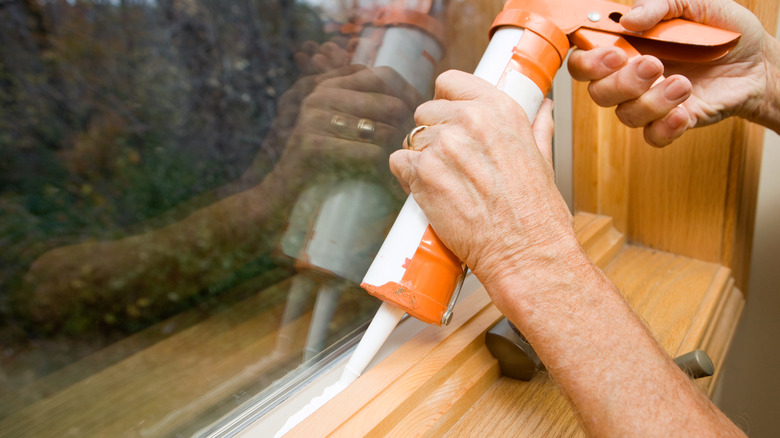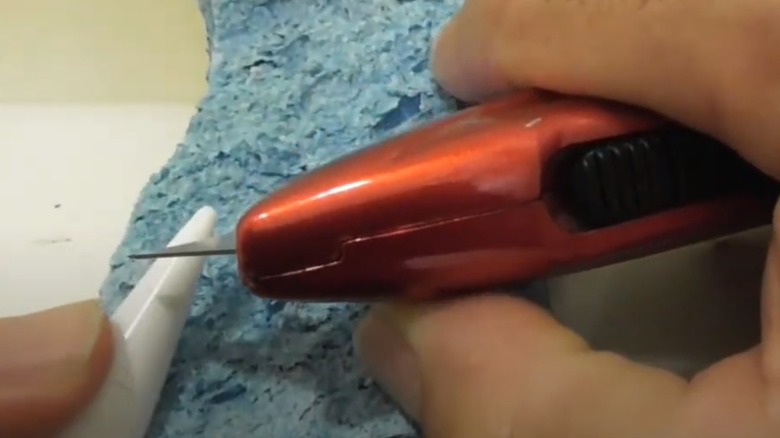This Hidden Caulking Gun Trick Is A Game Changer
Whether you need to caulk the edge of the bathtub, a countertop in the kitchen, or some windows, this material keeps water out of areas where you don't want it. You may already know that learning to use a caulking gun is the best means of spreading this material while causing as little mess as possible. What you may not know is that the majority of caulking guns have built-in features and tools needed to pop open the tube of caulk and begin using it. This particular hack clips the end off the tube and punctures the seal inside the nozzle, all without needing other tools.
Look at the side of the gun near the handle. You should see a small hole, roughly equal to the diameter of the nozzle on the tube. When you place the end of the tube's nozzle into this hole and press the handle, it will clip the end and create an opening that you can then use to apply the caulk.
Keep in mind that the tube has a seal inside that you must puncture before using it. The end of the gun should have a hidden narrow metal rod that you can swing out and use to puncture the seal inside the tube. Place the rod through the hole you just made to reach the seal.
Cutting the tube of caulk for the size of bead you want
Before cutting the end off the tube of caulk, think about what size of bead you need. Cutting the tip of the tube about ¼ inch from the end will give you an extremely narrow diameter bead of caulk. If you cut it closer to 1 inch from the end, you'll end up with a much wider diameter bead. Using a wider bead is preferable for larger jobs, such as near a bathtub, while a narrower one works better for small jobs, such as around a window or around woodwork. If you're still unsure, make the hole in the tube about two-thirds of the diameter of the bead you want for the job.
To make the bead and line of caulk as smooth as possible, you may want to use fine-grit sandpaper on the tip after you cut it — this removes imperfections in the tube's clipped plastic edge that could affect the smoothness of the bead as you apply it.
Additionally, you should cut the tip of the nozzle at an angle to deliver the caulk efficiently and smoothly. By cutting at an angle, the point you create in the nozzle's plastic directs the caulk into the seam efficiently, creating less mess. Many tubes of caulk have a 45-degree cut line imprinted on the nozzle, helping you cut it at the right angle.
What to do if your caulking gun doesn't have these built-in features
If you have an inexpensive caulking gun, it may not have a built-in hole for clipping the tip or a metal rod for puncturing the seal. If not, you can use a few different tools to open the tube without causing a significant mess.
Many different sharp-edged tools work for this purpose. A sturdy pair of scissors will do the trick, leaving a smooth edge in the plastic on the nozzle. You also can use pruning shears if you're working outside. A utility knife will also make an efficient cut. Just place the tip against a background that you don't want to keep — like thick cardboard or a sponge — and use the knife or a razor blade to push through the plastic. Keep your fingers out of the way while using these tools, as it takes some force to go through the flexible plastic in the nozzle. But once you're through, the cut occurs fast.
For puncturing the seal inside the nozzle, you need a narrow diameter, firm tool that's at least a few inches in length to break the seal. Typically, a screwdriver works well for this. You can also use a long nail or screw. In a pinch, a narrow twig will also do. Be sure to clean off the twig so it doesn't leave dirt or other debris inside the caulk.

